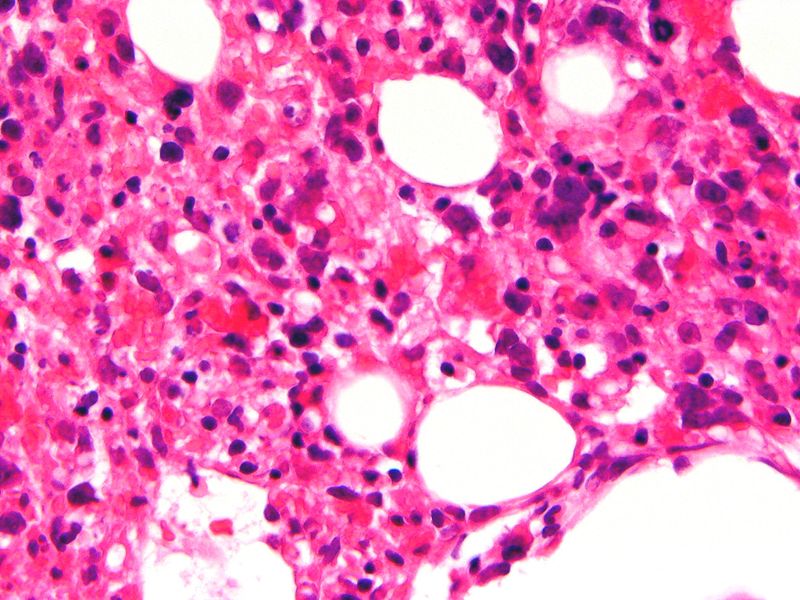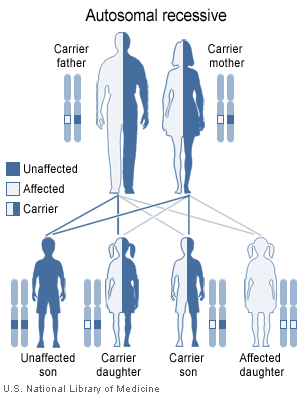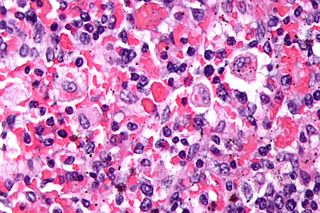Hemophagocytic lymphohistiocytosis: Difference between revisions
| Line 49: | Line 49: | ||
The five subtypes of FHL are each associated with a specific gene: | The five subtypes of FHL are each associated with a specific gene: | ||
* FHL1 - HPLH1 | * FHL1 - HPLH1 | ||
* FHL2 - PRF1 (Perforin) | * FHL2 - PRF1 (Perforin) | ||
| Line 56: | Line 54: | ||
* FHL4 - STX11 (Syntaxin 11) | * FHL4 - STX11 (Syntaxin 11) | ||
* FHL5 – STXBP2 (Syntaxin binding protein 2)/UNC18-2 | * FHL5 – STXBP2 (Syntaxin binding protein 2)/UNC18-2 | ||
Molecular genetic testing for four of the causative genes, PRF1 (FHL2), UNC13D (FHL3), STX11 (FHL4), and STXBP2 (FHL5), is available on a clinical basis. | Molecular genetic testing for four of the causative genes, PRF1 (FHL2), UNC13D (FHL3), STX11 (FHL4), and STXBP2 (FHL5), is available on a clinical basis. | ||
Revision as of 03:19, 1 August 2012
| Hemophagocytic lymphohistiocytosis | |
 | |
|---|---|
| Light microscopic image of bone marrow showing stromal macrophages containing numerous red blood cells in their cytoplasm | |
| ICD-10 | D76.1 |
| ICD-9 | 288.4 |
| OMIM | 267700 603552 |
| DiseasesDB | 31418 |
| MeSH | D051359 |
Editor-In-Chief: C. Michael Gibson, M.S., M.D. [1]; Associate Editor(s)-in-Chief: Raviteja Guddeti, M.B.B.S. [2]
Synonyms and keywords: Hemophagocytic syndrome, Familial histiocytic reticulosis, Hemophagocytic lymphohistiocytosis - familial, Erythrophagocytic lymphohistiocytosis - familial, Familial haemophagocytic lymphohistiocytosis
Overview
Hemophagocytic lymphohistiocytosis (HLH) is an uncommon hematologic disorder in which the immune system produces too many activated immune cells (lymphocytes) called T cells, natural killer cells, B cells, and macrophages (histiocytes). Excessive amounts of immune system proteins called cytokines are also produced.
Classification
HLH primarily categorized as
- Familial (primary) hemophagocytic lymphohistiocytosis (FHL)
- Secondary HLH (SHLH)
Familial forms
FHL, an autosomal recessive disorder, is invariably fatal when untreated. It is associated with defective triggering of apoptosis and reduced cytotoxic activity, resulting in a widespread accumulation of T lymphocytes and activated macrophages.
There are four types, and each is associated with a specific gene:

Pathophysiology
Excessive production of too many activated immune cells (lymphocytes) called T cells, natural killer cells, B cells, and macrophages (histiocytes) and cytokines by the immune system causes symptoms and damages liver and spleen and causes these organs to enlarge. Familial hemophagocytic lymphohistiocytosis also destroys blood-producing cells in the bone marrow, a process called hemophagocytosis. As a result, affected individuals have low numbers of red blood cells (anemia) and a reduction in the number of blood cells involved in clotting (platelets). A reduction in platelets may cause easy bruising and abnormal bleeding.
The brain may also be affected in familial hemophagocytic lymphohistiocytosis causing various symptoms and complications.
Genetics
Five genetic subtypes of the familial form of the disease (FHL1, FHL2, FHL3, FHL4, and FHL5) are described.
The five subtypes of FHL are each associated with a specific gene:
- FHL1 - HPLH1
- FHL2 - PRF1 (Perforin)
- FHL3 - UNC13D (Munc13-4)
- FHL4 - STX11 (Syntaxin 11)
- FHL5 – STXBP2 (Syntaxin binding protein 2)/UNC18-2
Molecular genetic testing for four of the causative genes, PRF1 (FHL2), UNC13D (FHL3), STX11 (FHL4), and STXBP2 (FHL5), is available on a clinical basis.
Microscopic Pathology

Epidemiology and Demographics
- Familial hemophagocytic lymphohistiocytosis occurs in approximately 2 in 100,000 individuals worldwide.
- Signs and symptoms of familial hemophagocytic lymphohistiocytosis usually become apparent during infancy, although occasionally they appear later in life. They usually occur when the immune system launches an exaggerated response to an infection, but may also occur in the absence of infection.
- Gender distribution is equal.
Natural History, Complications and Prognosis
- Without treatment, most people with familial hemophagocytic lymphohistiocytosis survive only a few months.
- Complications include
Diagnosis
History
Inquiry about family history may help diagnose the familial forms of Hemophagocytic lymphohistiocytosis.
Symptoms
Symptoms of FHL are usually evident within the first few months of life and may even develop in utero.
- Fever
- Rash on the skin
- Abdominal pain
- Easy bruising and abnormal bleeding
- Infections [1]
References
- ↑ Fisman DN (2000). "Hemophagocytic syndromes and infection". Emerging Infect. Dis. 6 (6): 601–608. PMID 11076718.
External links
- http://www.hrtrust.org/library/HLHSymptomsSignsAndDiagnosis.html
- http://www.histio.org
- http://www.jonahchuang.com
- http://www.elyseyu.com
- http://www.ethanmichaelsmith.com
- ↑ Henter JI, Samuelsson-Horne A, Aricò M; et al. (2002). "Treatment of hemophagocytic lymphohistiocytosis with HLH-94 immunochemotherapy and bone marrow transplantation". Blood. 100 (7): 2367–2373. doi:10.1182/blood-2002-01-0172. PMID 12239144.